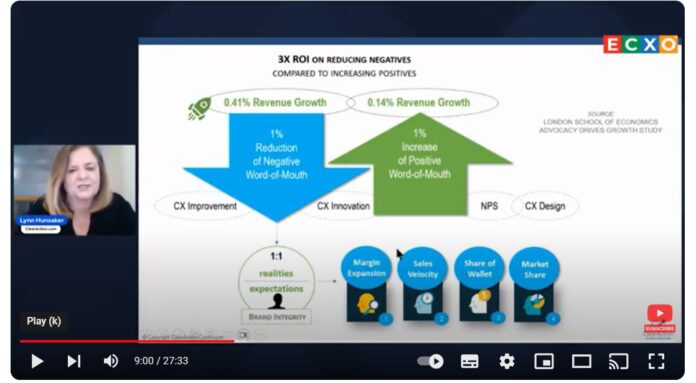This article was written as part of a partnership between 1to1 Media and the European Customer Experience Organization.
Criminy! Blast! Ouch! Barnacles!
That pebble in your shoe elicits a yelp and other colorful expletives. And yet, companies too often ignore this root friction point — all in pursuit of quick wins.
Stop that, said Lynn Hunsaker, chief customer officer of ClearAction Continuum, a Phoenix-based CX consulting and training company. As a former CX and QA executive at Fortune 250 companies, author, and professor, Hunsaker said she understands why it’s tempting to focus on building positive word of mouth instead of fixing negative word of mouth. Research backs up why that’s misguided.
Companies that reduce negative word of mouth 1% stand to increase revenue 3x more than those that improve positive word of mouth 1%, she said, citing findings from the London School of Economics “Advocacy Drives Growth” study.
“When you reduce negative word of mouth, you are taking pebbles out of your customers’ shoes, freeing them up to be more productive in their lives so they can engage with you more and can afford your premium products,” Hunsaker said last week during the “Fast-Track CX ROI with 3 Levels of Improvement” LinkedIn webinar hosted by the European Customer Experience Organization (ECXO).
This week’s Fast Track CX ROI webinar is the second episode in ECXO’s three-part series of short, practical sessions hosted by Ricardo Saltz Gulko, ECXO co-founder and managing director of Eglobalis, a global adviser in CX, design, and innovation. The first 20-minute webinar, “Mastering the Maze of CX Metrics & Money,” was presented in April. The final event in the series, “The Four Gold CX ROI Metrics,” will be June 5 at 10 a.m. ET.
Let go of friction to unlock revenue
“You are making a stronger 1:1 ratio between what customers expected and what they got,” Hunsaker continued. “Say what you do and do what you say.” Removing friction leads to lower costs, higher margins, market share, and sales velocity. “Customers will expand their purchases because you don’t put a pebble in their shoe — and everybody else does.”
Resist the lure of the quick win and go for an action plan that involves all teams that have impact, direct or not, on the customer experience.
Journey mapping is a valuable ongoing exercise but it’s not enough. A faster way to achieve ROI is to engage all stakeholders from customer support and product teams to engineers and other noncustomer-facing teams to get at the root source of friction. The ultimate goal is to discover the vital few CX issues in greatest need of resolution.
Hunsaker said spending at least 50% of your energy on reducing negative word of mouth will “bless you” in three ways that recapture value lost and create new value:
- Resolve each incident after a CX failure. First call resolution (FCR) is important, she said, but it’s better to avoid an incident altogether.
- Halt the root cause: “This is what I call ‘CX work’ rather than customer service or customer support,” she said. “CX work is stopping roadblocks to revenue and all the rigmarole of those pebbles.”
- Prevent occurrence of CX failure: This is achieved by ensuring every functional area in the organization understands their role in CX so everyone can push toward that 1:1 ratio between what customers expect and what they actually get — rather than “throwing things over the fence for customer support to handle,” Hunsaker said.
With each functional team educated about its role and impact on the customer experience, their input is crucial to identify the root cause of friction. Once symptoms are identified (inconvenience? usability? timeliness?) — companies must probe deeper to identify the underlying source of CX failures. You won’t get the right answer the first time you ask, “Why is this problem happening?”
Why ask ‘Why?’ 5 times
The real, hidden “why” needs to be teased out through a series of deeper questions. Consider:
- Why are customers unhappy? Slow delivery.
- Why is delivery slow? The warehouse is understaffed.
- Why is the warehouse understaffed? High turnover.
- Why is there high turnover? Low wages.
- Why are we not paying a competitive wage? Cost pressures. Competition is undercutting our prices through AI and other automation. They deliver our product faster, cheaper, and more efficiently.
This exercise uncovers strategic and investment opportunities leadership may be unwilling — or unable — to consider. A point solution won’t do the trick. A major strategic shift may be needed and that’s not a simple undertaking.
“This is the place almost every CX expert is giving you bad advice, to focus on the quick wins. But the quick wins won’t move the needle. The quick wins are not sufficient to remove the pebble in the customer’s shoe,” Hunsaker said.
Learn more about developing a CX action plan and delver deeper into Hunsaker’s insight. Watch the webinar on-demand.
ECXO, an open-access CX professional business network that continuously evolves with CX by empowering leaders, people, and organizations to collaborate, discuss, generate brand awareness, learn, and grow. Learn more at https://ecxo.org

